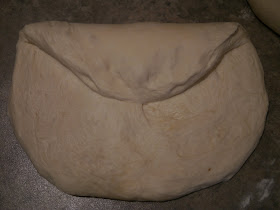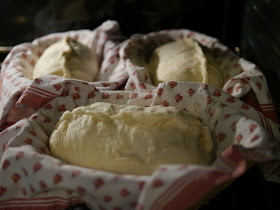Part 2: Sourdough Bread Recipe: More Feeding (Day 2)
This is a basic formula for making three loaves of sourdough bread using all-purpose flour. Use this recipe as a starting point for exploring the world of sourdough bread.
Suggested Equipment
an accurate scale*
three proofing baskets
three lint free cotton or linen napkins
large bowl
*a digital scale works very well but it can be pricey. I've added approximate cup measurements below but these can have varying results from person to person. Scale measurements are the most accurate.
Ingredients
800g ripe starter800g flour (~7 cups)
400g (or up to 600g) water (~ 2 + 2/3 cups)
22g salt (1 Tbsp. + 1 tsp.) (do not use iodized salt)
olive oil (optional)
3 Tbsp. falx seeds (optional)
Your starter should have doubled in size overnight. It is finally time to make some bread with it! Scrap the starter into a larger mixing bowl. Add 800g flour (~ 7 cups) and 400g water (~ 2 + 2/3 cups) and mix until there is no dry flour left. This is not kneading, just mixing the ingredients together. Cover the mixture and leave it for 20 minutes to an hour. This phase is called autolysis.
After autolizing the mixture add the salt. Do not forget the salt or your bread will be awfully bland. Add flax seeds at this point is you wish.
Begin kneading the bread. You can knead by hand or using a machine. If necessary add flour and water until the dough is a consistency that you like. Continue kneading and check the webbing of the dough as you go along. To check webbing take a piece of dough (a couple tablespoons) and gently pull the dough apart. If the dough rips continue kneading, when the dough stretches until the dough get very thin and you can almost see through it you have kneaded enough. This is called the windowpane test. There are a lot of variables that affect the length of time you will knead. By hand it can take up to 20 minutes and by machine it might be less time, closer to 15 minutes.
Place the kneaded dough in a large bowl. You can add a little olive oil in the bottom or the bowl to prevent sticking. Cover the bowl and let is rise for 1 hour in a warm location. I place my dough in a oven with the pilot light on. I don't cover the dough but I add a measuring cup of hot water to create steam in the oven.
Fold the dough. Stretch the dough and then fold the corners in to form a ball. The dough should be warm (23-25C/73/76F).
Cover the dough and let it rise for another 1 hour.
Fold the dough a second time. You should notice the dough becoming stretchy and soft.
Cover the dough and let rise for about 2 hours.
The process of fermenting the dough takes a total of 4 hours. After about 4 hours the dough should feel soft with body to it. Poke a 1/2 inch hole into the dough with a wet finger. When the hole does not fill in it is ready. If the dough springs back let it continue to rise for another hour or so.
Scrap the dough onto your counter and divide it into three equal pieces. You can use a scale to do this, or eyeball it. Try not to incorporate too much raw flour into the dough a this point.
Take each piece of dough and gently shape it into a ball by tucking in the corners. Leave the dough on the counter to relax for 15 minutes.
While you wait prepare three proofing baskets by lining them with lint free cotton or linen napkins. You can get these baskets from kitchen stores, restaurant supply stores and sometimes even thrift stores. They aren't expensive. The napkin can be any old napkin, just make sure they aren't too fuzzy. I found mine at a thrift shop. Dust the cloth covered baskets with flour.
Shape each ball as follows:
Flip the ball over and using you hands and fingertips gently stretch the ball into a circle (about 9 inches).
Fold the top of the circle down about 1/3 or just less than half of the way.
Fold the two corners in towards the middle as if you were putting on the straps of a baby's diaper.
Using both hand take the bottom of the circle and fold it over and around the top.
Pinch the dough together to create a seem. Place shaped dough into proofing baskets with the seam side facing up.
Rise in a warm place for 1.5 hours or longer. Check the dough readiness with the poke test. The dough should fill in slowly when poked. Don't over-proof your bread or you will end up with bread that won't rise in the oven. I find it is better to underestimate this phase rather than overestimate it if you are unsure.
Preheat the oven to 450F.
Turn your loaves onto a baking sheet. The seams should be on the under side. Don't place your loaves too close together.
Make three slashes on each ball of dough with a sharp serrated knife to about 1/2 inch deep. Put the sheets into the oven.
After 15 minutes reduce the temperature to 400F. Bake for another 25 to 30 minutes. The total baking time should be 40 to 45 minutes.
The bread is ready when it is nicely browned and sounds hollow when you knock the bottom.




















I have been following your method for making sourdough bread and it by far the best bread I have ever made thank you!!
ReplyDeleteQuick question, if the starter will be in the fridge for a while, without making bread for about a month, do I need to do anything to it?
Thanks so much!
You are so welcome! I'm glad that this method is working for you.
DeleteThe starter: you can leave it in the fridge for a week to ten days without feeding, maybe longer depending on how cool you keep your fridge. After a week or so you'll need to "feed" your starter. You do this by repeating Day 1 (add 100g water, 100g flour and divide in half). Put half back in the fridge and the other half you can mix into muffins, pancakes, pizza dough, start another batch of bread, give to a friend... or throw away if you can't think of any way to use it.
If you have to leave for longer than a month you can ask a friend to feed your starter while you're gone (once a week is best. Remember that the yeast in your starter are living organisms so they need food to stay alive. There might be other ways to store starters for long periods but I don't have much information about those techniques. I'll let you know if I come across anything though.
Thanks for this thorough explanation! I haven't heard to do the three days of prepping the starter before, so I'll have to give that a try. Have you used spelt for sourdough? That's what I tried the other day.
ReplyDeletehttp://www.nourishedroots.ca
I haven't tried spelt yet but I would like to try soon. The baker that taught me made spelt bread and it was one of her favourites but she did say that it can be a little tricky. I could always ask her for a few tips if you'd like.
Delete